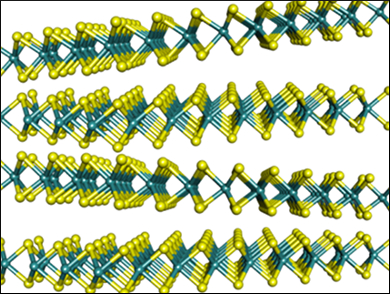Layered materials are important in energy storage and have been utilized in various types of rechargeable batteries. However, most layered materials reported so far, such as lithium cobalt oxide and graphite in lithium-ion batteries, deliver moderate or sluggish reaction kinetics. The diffusion-limited Li+ intercalation into the layered materials hinders ultrafast energy storage.
Yan Yao, Hyun Deog Yoo, and colleagues, University of Houston, TX, USA, have synthesized chemically exfoliated molybdenum disulfide (MoS2), a layered substance with promising properties for energy storage. The team soaked molybdenum disulfide powder in n-butyllithium/hexane to form LixMoS2. The lithiated product was exfoliated in water to form a quasi-stable suspension of single-layered MoS2. They then restacked the exfoliated MoS2 by drying the suspension. The restacked MoS2 (pictured) showed slight structural expansion and a metallic 1T-phase with high electronic conductivity.
The exfoliated structure reduces the kinetic barrier for the Li+ intercalation substantially, so that the intercalation is no longer diffusion-limited. Rather, the exfoliated MoS2 shows surface-limited intercalation pseudocapacitance, which enables ultrafast energy storage with an enhanced capacitance of 250 F/g. This value is about two times larger than that for the commonly used activated carbon.
- Intercalation Pseudocapacitance of Exfoliated Molybdenum Disulfide for Ultrafast Energy Storage,
Hyun Deog Yoo, Yifei Li, Yanliang Liang, Yucheng Lan, Feng Wang, Yan Yao,
ChemNanoMat 2016.
DOI: 10.1002/cnma.201600117



